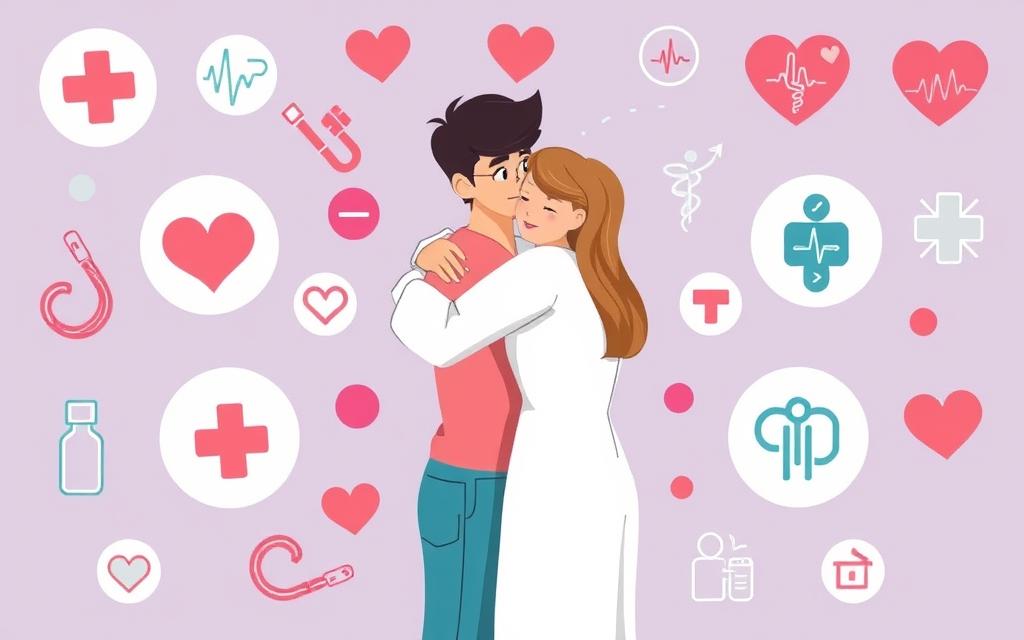Do STDs Go Away? What You Need to Know
Sexually transmitted infections (STIs) and sexually transmitted diseases (STDs) are a significant concern for millions of Americans each year. Many individuals wonder if these conditions can resolve on their own without treatment.

Understanding the nature of STIs/STDs is crucial for maintaining sexual health and preventing long-term health consequences. These infections can manifest through various symptoms, and if left untreated, can lead to serious health issues.
It’s essential to differentiate between STIs and STDs, understand their transmission methods, and explore available treatment options. This comprehensive guide addresses the critical question: “Do STDs go away on their own?” and provides medically accurate information to help readers make informed decisions about testing and treatment.
Key Takeaways
- STIs/STDs can have severe health consequences if left untreated.
- Understanding the differences between STIs and STDs is crucial for proper diagnosis and treatment.
- Various symptoms can indicate the presence of an STI/STD.
- Testing is a critical step in diagnosing and treating STIs/STDs.
- Timely treatment can prevent long-term health complications.
- Non Sexually Transmitted Diseases: Symptoms, Causes, Treatment
- Girl and Horse Sexually Transmitted Diseases
Understanding STDs vs. STIs: The Key Differences
Understanding the distinction between sexually transmitted infections (STIs) and sexually transmitted diseases (STDs) is crucial for maintaining good sexual health. The difference between an STI and an STD typically lies in the fact that a substantial number of these infections can be present without signs or symptoms of a particular clinical disease.
What These Terms Mean
The terms STI and STD are often used interchangeably, but they represent different stages of the same health issue. An STI refers to the presence of an infection that has been transmitted through sexual contact, which may or may not produce noticeable symptoms. When an STI progresses and begins causing symptoms or damage to the body’s tissues, it’s then classified as an STD.
Why Terminology Matters
This distinction is important because many people with STIs don’t experience symptoms but can still transmit the infection to others. Understanding the difference helps emphasize the importance of regular testing even when symptoms aren’t present, as early detection and treatment can prevent progression from infection to disease. Healthcare providers often prefer the term STI because it carries less stigma and better describes the asymptomatic nature of many sexually transmitted conditions.
The shift in terminology also encourages more open conversations about sexual health and testing, which is crucial for preventing the spread of STIs and STDs.
Common Sexually Transmitted Diseases and Their Symptoms
The symptoms of sexually transmitted diseases can vary significantly depending on the type of infection. While some individuals may not exhibit any symptoms at all, others may experience a range of signs that can be uncomfortable and concerning.
Bacterial STDs: Chlamydia, Gonorrhea, and Syphilis
Bacterial STDs, including chlamydia, gonorrhea, and syphilis, are caused by bacterial infections. Chlamydia and gonorrhea often present with symptoms such as discharge and painful urination, although many cases are asymptomatic. Syphilis progresses through stages, beginning with a painless sore called a chancre. These infections typically respond well to antibiotic treatment when caught early.
Viral STDs: Herpes, HPV, HIV, and Hepatitis
Viral STDs include herpes (HSV-1 and HSV-2), which causes recurring outbreaks of painful blisters around the genitals or mouth; human papillomavirus (HPV), which can cause genital warts or lead to certain cancers; HIV, which attacks the immune system; and hepatitis B and C, which affect the liver. Unlike bacterial infections, viral STDs typically cannot be cured completely, though symptoms and transmission risk can often be managed with appropriate medications.
Parasitic STDs: Trichomoniasis
Parasitic STDs like trichomoniasis (“trich”) are caused by microscopic parasites. Trichomoniasis can lead to symptoms such as genital itching, burning, and discharge. Fortunately, it can be treated effectively with medication, providing relief from symptoms and reducing the risk of transmission.
Many STIs cause no noticeable symptoms, especially in their early stages, which is why regular testing is essential for sexually active individuals. When symptoms do appear, they often include unusual discharge, genital sores or bumps, painful urination, itching, and in some cases, systemic symptoms like fever or rash.
How STDs Are Transmitted
Knowing the modes of STD transmission is key to reducing risk. Sexually transmitted infections develop when bacteria, viruses, or parasites infect the body, typically through sexual activities or contact with infected bodily fluids.
Sexual Contact Transmission
STDs are primarily transmitted through sexual contact, including vaginal, anal, and oral sex, where there’s an exchange of body fluids or skin-to-skin contact. Different STDs have different transmission methods; some require fluid exchange, while others can spread through skin contact with infected areas.
- Exchange of bodily fluids like semen, vaginal fluids, and blood during sex.
- Skin-to-skin contact with infected areas, even without visible symptoms.

Non-Sexual Transmission Routes
Certain STDs can be transmitted non-sexually, such as from mother to child during pregnancy or childbirth, particularly for HIV, syphilis, and herpes. Sharing needles or equipment for injecting drugs also poses a risk.
- Mother-to-child transmission during pregnancy or childbirth.
- Sharing needles or drug equipment.
- Sharing personal items with blood on them, like razors or toothbrushes.
Myths About STD Transmission
Common myths surround STD transmission, including the belief that STDs can be contracted from toilet seats, swimming pools, or casual contact. Another misconception is that withdrawal before ejaculation prevents STD transmission.
- STDs cannot be contracted from toilet seats, swimming pools, or casual contact.
- Withdrawal before ejaculation does not prevent STD transmission due to potential pre-ejaculate or skin contact.
Understanding the facts about STD transmission is crucial for effective prevention and risk reduction strategies.
Do STDs Go Away on Their Own?
The persistence of STDs is a common concern, raising the question of whether these infections can resolve without medical intervention. The answer to this question is complex and depends on the type of STD—whether it’s bacterial, viral, or parasitic.
Bacterial STDs and Natural Clearance
Some bacterial STDs, such as chlamydia, may occasionally clear without treatment in a small percentage of cases. However, this is unpredictable and not a recommended management strategy. Most bacterial infections require antibiotic treatment to be fully eliminated from the body.
- Chlamydia may clear without treatment, but this is not medically recommended.
- Antibiotics are necessary for eliminating most bacterial STDs.
- Waiting for natural clearance can lead to the infection spreading.
Viral STDs and Long-Term Persistence
Viral STDs, including herpes, HIV, and HPV, typically do not go away on their own. Once infected, the virus remains in the body indefinitely, although symptoms may come and go. The immune system may control the infection to varying degrees but cannot completely eliminate the virus.

The Dangers of Waiting It Out
Ignoring symptoms and not seeking medical evaluation and treatment can result in negative health consequences for the individual and their sexual partners. The dangers of “waiting it out” include developing serious complications and unknowingly transmitting the infection.
- Serious complications can develop if STDs are left untreated.
- Unknowingly transmitting the infection to partners is a significant risk.
- Delayed treatment can lead to more difficult or prolonged care.
Even when symptoms disappear, it doesn’t necessarily mean the infection is gone. Many STDs can remain asymptomatic while continuing to cause damage or remain transmissible. Therefore, it’s crucial to seek medical help if you suspect you have an STD.
Treatment Options for Different Types of STDs
STDs require different treatment strategies depending on whether they are caused by bacteria, viruses, or parasites. The type of treatment ultimately depends on the specific STI, but appropriate screening and prompt diagnosis are crucial for effective management.
Antibiotics for Bacterial Infections
Bacterial STDs like chlamydia, gonorrhea, and syphilis are typically treated with specific antibiotics that can completely eliminate the infection when taken as prescribed. Antibiotics are the treatment of choice for these infections, emphasizing the importance of completing the full course of medication to ensure the infection is fully cleared.
Managing Viral STDs
For viral STDs such as herpes, HIV, and hepatitis, treatment focuses on managing symptoms and reducing viral load rather than achieving a cure, as these infections cannot be completely eliminated from the body. Antiviral medications for herpes can reduce the frequency and severity of outbreaks, while HIV treatment, known as antiretroviral therapy, can suppress the virus to undetectable levels.

When to Seek Medical Help
Medical help should be sought immediately if you experience symptoms of an STD, have had unprotected sex with someone who may have an STD, or if you’re sexually active and haven’t been tested recently. Self-diagnosis and self-treatment are strongly discouraged, as they can lead to incomplete treatment, antibiotic resistance, and continued transmission. Timely diagnosis and treatment can prevent short- and long-term complications and help prevent transmission to sex partners and unborn children.
It’s essential to consult a doctor or a healthcare provider for proper diagnosis and treatment. They can provide guidance on the best course of treatment based on the type of STD and individual health needs.
Complications of Untreated STDs
Failing to treat STDs can have serious and lasting consequences. When STDs are left untreated, they can lead to a range of health issues that affect not only the individual but also their sexual partners and, in the case of pregnant people, their unborn children.
Short-Term Health Risks
In the short term, untreated STDs can cause painful symptoms and spread to sexual partners. Common short-term complications include infections in the urethra and prostate in men, and pelvic inflammatory disease (PID) in women.

Long-Term Consequences
Long-term consequences of untreated STDs are severe and can include chronic pelvic pain, increased risk of certain cancers, and permanent damage to reproductive organs. For instance, untreated syphilis can damage the brain, nervous system, and other organs over time.
Impact on Fertility and Pregnancy
Untreated STDs can lead to infertility in people. In women, it can cause PID, leading to scarring of the fallopian tubes and increased risk of ectopic pregnancy. During pregnancy, untreated STDs can result in premature birth, low birth weight, and transmission of the infection to the baby.
In Conclusion: Prevention and Regular Testing
Maintaining sexual health requires a proactive approach, including prevention and regular STD testing. Prevention remains the most effective strategy against STDs, with consistent and correct use of barrier methods like condoms providing significant protection during vaginal, anal, and oral sex.
Regular testing is essential for sexually active individuals, especially those with new or multiple partners. Open communication with sexual partners about STD status and testing history is also crucial. Vaccination offers protection against several STDs, including HPV and hepatitis B. For those at high risk of HIV exposure, pre-exposure prophylaxis (PrEP) can significantly reduce the risk of infection. By combining these strategies, individuals can significantly reduce their risk of contracting and transmitting STDs.
FAQ For Do STDs Go Away
Q1. What are the most common sexually transmitted diseases?
Ans: The most common sexually transmitted diseases include chlamydia, gonorrhea, syphilis, herpes, HPV, HIV, and hepatitis. These infections can be bacterial, viral, or parasitic and can be transmitted through various forms of sexual contact.
Q2. Can sexually transmitted infections be cured?
Ans: Bacterial STDs, such as chlamydia and gonorrhea, can be cured with antibiotics. However, viral STDs, like herpes and HIV, cannot be cured but can be managed with antiviral medications. Parasitic STDs, such as trichomoniasis, can also be treated with medication.
Q3. How can I reduce my risk of getting an STD?
Ans: Practicing safe sex by using condoms, getting vaccinated against HPV and hepatitis, and limiting your number of sexual partners can reduce your risk of getting an STD. Regular testing is also crucial in detecting and treating infections early.
Q4. What are the symptoms of STDs?
Ans: Symptoms of STDs can vary widely but often include unusual discharge, pain during urination, sores or blisters around the genitals, and itching. Some STDs, like chlamydia, may not show any symptoms at all, making regular testing essential.
Q5. Can I still get an STD if I’m in a monogamous relationship?
Ans: Yes, you can still be at risk for STDs even in a monogamous relationship if your partner has an infection. It’s essential for both partners to get tested before becoming sexually active together.
Q6. How often should I get tested for STDs?
Ans: The frequency of STD testing depends on your sexual activity and risk factors. Generally, sexually active individuals should get tested at least once a year. Those with multiple partners or engaging in high-risk behaviors may need more frequent testing.
Q7. Can STDs affect fertility or pregnancy?
Ans: Untreated STDs can lead to complications such as infertility, miscarriage, and passing the infection to the baby during pregnancy or childbirth. Regular testing and prompt treatment can help prevent these complications.
Q8. Are there vaccines available for any STDs?
Ans: Yes, vaccines are available for HPV and hepatitis, which can protect against certain strains of these viruses. Vaccination is a crucial preventive measure, especially before becoming sexually active.












